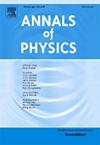Multimodal signatures of asymptotic (A)dS Kalb–Ramond black holes: Constraints through the shadow, weak deflection angle, and topological photon spheres
IF 3
3区 物理与天体物理
Q2 PHYSICS, MULTIDISCIPLINARY
引用次数: 0
Abstract
This study explores novel static, neutral black hole solutions within Kalb–Ramond (KR) gravity in asymptotically (anti-)de Sitter [(A)dS] spacetimes, incorporating spontaneous Lorentz symmetry breaking (LSB) via an antisymmetric tensor field. Focusing on two metric configurations, we derive general analytical expressions for the horizon radius, photon sphere, shadow radius, and weak gravitational deflection angle. The universality of these expressions enables their applicability to a broad class of non-rotating spacetimes beyond KR gravity. By confronting these models with empirical data from the Event Horizon Telescope (EHT) and Solar System experiments, the work yields tight constraints on the Lorentz-violating parameter , demonstrating that certain parameterizations – particularly Case B – yield observationally viable and physically consistent outcomes. Additionally, we employ topological methods to analyze black hole thermodynamics and photon sphere stability, uncovering critical geometrical structures in both thermodynamic and optical contexts. These multimodal signatures collectively offer a powerful framework for testing Lorentz-violating extensions of General Relativity (GR) and highlight the potential of topological diagnostics in gravitational physics.
渐近(A)dS Kalb-Ramond黑洞的多模态特征:阴影、弱偏转角和拓扑光子球的约束
本研究探索了渐近(反)德西特[(A)dS]时空中卡尔布-拉蒙(KR)引力下的新型静态中性黑洞解,通过反对称张量场结合了自发洛伦兹对称破缺(LSB)。以两种度量结构为中心,导出了视界半径、光子球半径、阴影半径和弱引力偏转角的一般解析表达式。这些表达式的通用性使它们能够适用于广义的非旋转时空,而不是KR引力。通过将这些模型与事件视界望远镜(EHT)和太阳系实验的经验数据进行对比,研究工作得出了对违反洛伦兹参数的严格约束,证明了某些参数化——特别是情况B——产生了观测上可行和物理上一致的结果。此外,我们采用拓扑方法分析黑洞热力学和光子球稳定性,揭示了热力学和光学背景下的关键几何结构。这些多模态特征共同为检验广义相对论(GR)的违反洛伦兹扩展提供了一个强大的框架,并突出了引力物理中拓扑诊断的潜力。
本文章由计算机程序翻译,如有差异,请以英文原文为准。
求助全文
约1分钟内获得全文
求助全文
来源期刊

Annals of Physics
物理-物理:综合
CiteScore
5.30
自引率
3.30%
发文量
211
审稿时长
47 days
期刊介绍:
Annals of Physics presents original work in all areas of basic theoretic physics research. Ideas are developed and fully explored, and thorough treatment is given to first principles and ultimate applications. Annals of Physics emphasizes clarity and intelligibility in the articles it publishes, thus making them as accessible as possible. Readers familiar with recent developments in the field are provided with sufficient detail and background to follow the arguments and understand their significance.
The Editors of the journal cover all fields of theoretical physics. Articles published in the journal are typically longer than 20 pages.
 求助内容:
求助内容: 应助结果提醒方式:
应助结果提醒方式:


